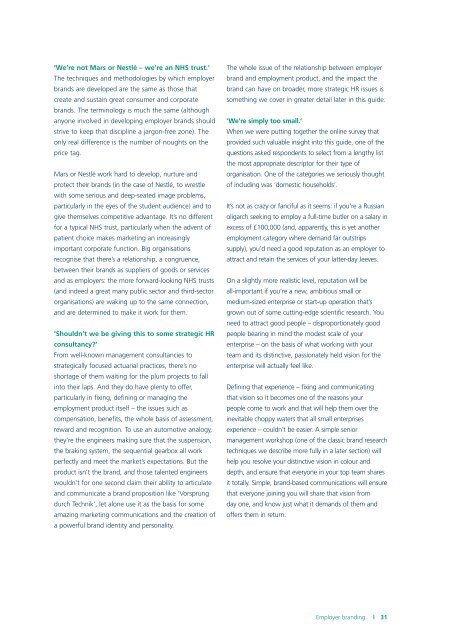Employer branding A no-nonsense approach - CIPD
Employer branding A no-nonsense approach - CIPD
Employer branding A no-nonsense approach - CIPD
You also want an ePaper? Increase the reach of your titles
YUMPU automatically turns print PDFs into web optimized ePapers that Google loves.
‘We’re <strong>no</strong>t Mars or Nestlé – we’re an NHS trust.’<br />
The techniques and methodologies by which employer<br />
brands are developed are the same as those that<br />
create and sustain great consumer and corporate<br />
brands. The termi<strong>no</strong>logy is much the same (although<br />
anyone involved in developing employer brands should<br />
strive to keep that discipline a jargon-free zone). The<br />
only real difference is the number of <strong>no</strong>ughts on the<br />
price tag.<br />
Mars or Nestlé work hard to develop, nurture and<br />
protect their brands (in the case of Nestlé, to wrestle<br />
with some serious and deep-seated image problems,<br />
particularly in the eyes of the student audience) and to<br />
give themselves competitive advantage. It’s <strong>no</strong> different<br />
for a typical NHS trust, particularly when the advent of<br />
patient choice makes marketing an increasingly<br />
important corporate function. Big organisations<br />
recognise that there’s a relationship, a congruence,<br />
between their brands as suppliers of goods or services<br />
and as employers: the more forward-looking NHS trusts<br />
(and indeed a great many public sector and third-sector<br />
organisations) are waking up to the same connection,<br />
and are determined to make it work for them.<br />
‘Shouldn’t we be giving this to some strategic HR<br />
consultancy?’<br />
From well-k<strong>no</strong>wn management consultancies to<br />
strategically focused actuarial practices, there’s <strong>no</strong><br />
shortage of them waiting for the plum projects to fall<br />
into their laps. And they do have plenty to offer,<br />
particularly in fixing, defining or managing the<br />
employment product itself – the issues such as<br />
compensation, benefits, the whole basis of assessment,<br />
reward and recognition. To use an automotive analogy,<br />
they’re the engineers making sure that the suspension,<br />
the braking system, the sequential gearbox all work<br />
perfectly and meet the market’s expectations. But the<br />
product isn’t the brand, and those talented engineers<br />
wouldn’t for one second claim their ability to articulate<br />
and communicate a brand proposition like ‘Vorsprung<br />
durch Technik’, let alone use it as the basis for some<br />
amazing marketing communications and the creation of<br />
a powerful brand identity and personality.<br />
The whole issue of the relationship between employer<br />
brand and employment product, and the impact the<br />
brand can have on broader, more strategic HR issues is<br />
something we cover in greater detail later in this guide.<br />
‘We’re simply too small.’<br />
When we were putting together the online survey that<br />
provided such valuable insight into this guide, one of the<br />
questions asked respondents to select from a lengthy list<br />
the most appropriate descriptor for their type of<br />
organisation. One of the categories we seriously thought<br />
of including was ‘domestic households’.<br />
It’s <strong>no</strong>t as crazy or fanciful as it seems: if you’re a Russian<br />
oligarch seeking to employ a full-time butler on a salary in<br />
excess of £100,000 (and, apparently, this is yet a<strong>no</strong>ther<br />
employment category where demand far outstrips<br />
supply), you’d need a good reputation as an employer to<br />
attract and retain the services of your latter-day Jeeves.<br />
On a slightly more realistic level, reputation will be<br />
all-important if you’re a new, ambitious small or<br />
medium-sized enterprise or start-up operation that’s<br />
grown out of some cutting-edge scientific research. You<br />
need to attract good people – disproportionately good<br />
people bearing in mind the modest scale of your<br />
enterprise – on the basis of what working with your<br />
team and its distinctive, passionately held vision for the<br />
enterprise will actually feel like.<br />
Defining that experience – fixing and communicating<br />
that vision so it becomes one of the reasons your<br />
people come to work and that will help them over the<br />
inevitable choppy waters that all small enterprises<br />
experience – couldn’t be easier. A simple senior<br />
management workshop (one of the classic brand research<br />
techniques we describe more fully in a later section) will<br />
help you resolve your distinctive vision in colour and<br />
depth, and ensure that everyone in your top team shares<br />
it totally. Simple, brand-based communications will ensure<br />
that everyone joining you will share that vision from<br />
day one, and k<strong>no</strong>w just what it demands of them and<br />
offers them in return.<br />
<strong>Employer</strong> <strong>branding</strong>

















